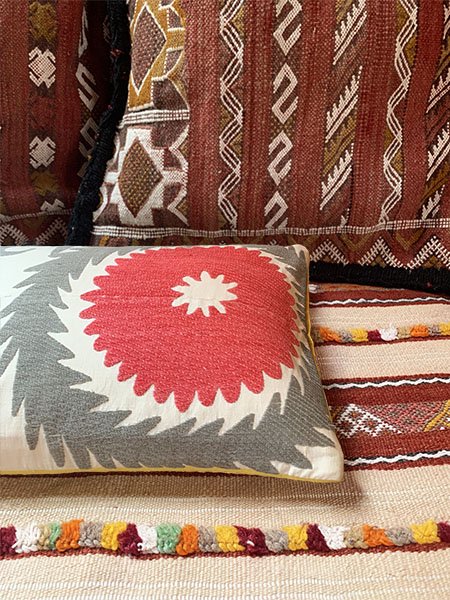Detail of a 19th-century suzani from Tashkent in Tamerlane’s Daughters’ textile archive
SUZANI
Suzani were elaborate embroideries made in Central Asia between the late 18th and early 20th century.
Breathtakingly poetic, their dreamy designs and dramatic use of colour often evoke a Matisse painting.
They are widely regarded as the most important of Central Asia’s rich textile traditions.
Made for Ceremony
Traditionally, suzani were created for a girl’s bridal dowry and served important ceremonial functions at her wedding.
The work was a source of family pride, something to be admired by the whole community and enjoyed for the rest of one's life.
Tajik ‘bridal curtain’ wedding ceremony with suzani, 1870
A 19th-century suzani from Shakhrisabz
Production Often Took Years
An unbelievable amount of time and care went into the embroidery of each piece.
Several female relatives worked simultaneously on a single suzani over the course of many months, sometimes up to five years.
The Original Textile Wall Art
After the wedding, suzani embellished the walls of the place of honour in the newlyweds’ home.
Wealthy family with suzani as wall art, 1897
An early 20th-century suzani from Samarkand
Designs Were Regional
Every region developed its own distinctive design.
While many common motifs were shared and go back 3,000 years, it was the arrangement of these motifs on the surface, and their colour schemes, that set apart the suzani of different regions.
The Sun, the Moon, and the Stars
Popular motifs included stylised versions of the sun, moon and stars symbolising continuity, flowers representing abundance, and pomegranates signifying fertility.
A 19th-century suzani from Tashkent
Detail of an 18th-century suzani from Bukhara
Silk, Cotton, and Vegetable Dyes
Typically, the embroidery was done in silk on a cotton background.
Natural dyes were used and included indigo for blue, cochineal and madder for red, wild saffron for yellow, and pomegranate skins for black.
Soviet-era Suzani
As women gained access to education during Soviet times, their priorities shifted away from needlework.
Though the production of suzani never fully stopped, pieces made in the 20th century gradually became less sophisticated.
‘New Life’ by Soviet photography legend Max Penson, 1930s
Detail of an antique 19th-century vs a contemporary suzani from Bukhara
Contemporary Suzani
Suzani are still made in Uzbekistan today, but have recently become commercially produced textiles.
Created for profit rather than personal pride, they most often lack the romance and imagination of older pieces.
Modern suzani are easily recognised by their use of synthetic instead of natural dyes.
Tamerlane’s Daughters’ Museum-Quality Antique Suzani
Karina uses only antique suzani in her work, mostly dating to the 19th and early 20th century.
The craftsmanship and poetic beauty of these pieces, made for personal prestige rather than profit, is simply unmatched by later embroideries.
One-of-a-kind coat by Tamerlane’s Daughters created from an antique suzani
Our collections of Couture Cushions made from antique suzani are available exclusively through our
ONLINE SHOP











